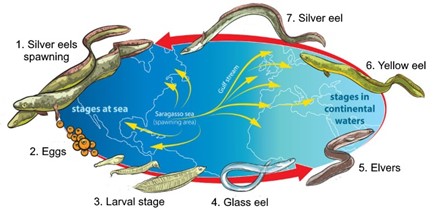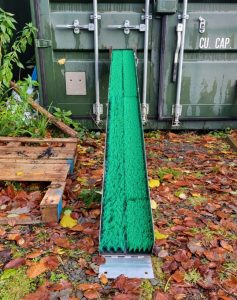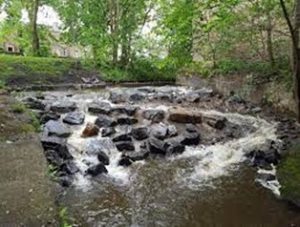By Hannah Teagle – Project Officer
The European Eel (Anguilla anguilla) is widely distributed throughout Europe but starts its life 4000 miles away in the Sargasso Sea. Soon after hatching as transparent ‘glass eels’, they start the journey towards Europe using the Gulf Stream.
Once in Europe (if they make it) the eels enter the freshwater system, growing into elvers in becks and rivers where they can remain from 5 to 20 years! The last stage of their life is as ‘Silver eels’, where they return to the Sargasso Sea to breed and then die.

Copyright: lukaves / 123RF Stock Photo
However, due to declining populations, the European eel is categorised as critically endangered. They are on the International Union for Conservation of Nature (IUCN) Red List of Threatened Species.
Why? Well, this decline is driven by a number of factors, including: overfishing for food, barriers to migration and parasitic disease introduced from stocked populations. In South Cumbria, migration routes are impacted by a number of barriers, like weirs or dams. SCRT AMbOM Eels project aims to improve migration routes, by installing easements on a series barriers throughout the Furness peninsula.

Figure 1:A photograph of a tray style bristle board eel pass, soon to be installed in the Furness peninsula!
In order to ease migration over barriers, we will use four types of eel pass or easement. The most common pass is a solid bristle board tray. This consists of a solid metal tray, containing two types of bristle board. When water flows down the pass, the bristles help eels find their way up the barrier. This is suitable for large weirs, where removal/modification is either not possible or cost effective. On smaller weirs, this can be replicated with flexible bristle board, which moves with different flow rates.
Where feasible, a rock ramp is a viable option. This consists of installing a set of rocks or boulders in a gentle slope from the bottom to the top of the barrier, creating a series of pools for eels and fish to rest and the move up the barrier. Rock ramps are more permanent features, that replicate natural processes.

Figure 2: A photograph of a rock ramp installed by one of our neighbouring trusts, Ribble Rivers Trust. A similar design will be used on some of our smaller weirs.
Weirs are not the only manmade features causing challenges to eel migration. Flat, smooth surfaces such as culverts or road fords can be difficult for eels to move across. An eel rope, similar to that for rope mussel use, can be installed to create a pathway. The rope creates a substrate which eels can climb against the flow of water.
We’ll ill be busy in the Furness peninsula over the next few months installing our first eel passes of the AMbOM eel project. Keep an eye out about updates, pictures as and when they are installed!
The Eels (England and Wales) Regulations (2009) states that the ‘construction or maintenance of a structure in or near waters that amounts to, or is likely to amount to, an obstruction, by service of a notice, the Agency may require a responsible person, at their own cost, to—(a)construct an eel pass; (b)make alterations to an existing eel or fish pass; (c)operate an existing eel pass in accordance with any conditions stated in the notice; (d)remove an obstruction; or (e)take any other action specified in the notice.
So, if you a structure owner and would like advice, please get in touch.
With thanks to BAE Systems plc and United Utilities who are funding the project.
